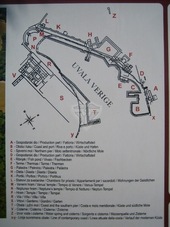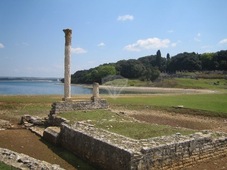to enlarge


or choose the place
from the menu below
 Rome |
 Byzantium |
 Venice |
 Vienna |
 Brioni |
 Smrikve |
 |
 |
This was the largest Roman residential complex in Istria built in the 1st century AD. The building started during the 1st century BC.
At the time Pula, Fazana, Porec, Labin and Medulin were the towns and villages where several people linked to the Emperor’s family lived, and the beauty of this villa was at the Emperor’s level.
The assumptions are that the owner of this villa could have been the Roman Consul Lecanio from Fazana, or the family of the Emperor Augustus and his successors Emperor Tiberio and Emperor Claudio, etc.
 The excavated remains of this complex encompass
a space of around five hectares. The complex consisted of a villa as the base of the complex and two atriums surrounded by
rooms.
The excavated remains of this complex encompass
a space of around five hectares. The complex consisted of a villa as the base of the complex and two atriums surrounded by
rooms.
A huge portico with loggia was connecting every room. The villa had also the peristyle.
On one side of the Bay a huge part of the villa was used by the landowner, guests and servants. This part had its own huge well on the highest spot of the villa. The villa also had a library, three level terraces and huge gardens from the villa until the southern pear.
There were also three temples in the middle of the bay: the Venus Temple on one side and a symmetric Neptun Temple on the other side. The name of the temple that was located in the middle is not known. Chambers for priests were located nearby the Venus Temple.
On the other side of the Bay, nearby the northern pear, there was the part dedicated to the economic activity consisted of the water pool, anchorage, fish pond, thermal places, palestra, olives mills and fullonica.
The water spring was located in the northern part of the Bay few hundred meters above palestra and the thermal area.
 The columns of the Venus
Temple have been preserved and also part of the public thermae. Part of the pier and a big swimming pool are visible
from the air because today a big part of the villa is under the sea level.
The columns of the Venus
Temple have been preserved and also part of the public thermae. Part of the pier and a big swimming pool are visible
from the air because today a big part of the villa is under the sea level.
In 1979 also a fullonica building was discovered. Fullonica was a special factory for the tunic cleaning.
All these buildings with an interesting system of covered and open promenades stretching for one kilometre along the sea were connected into a single unit ideally fitting with the environment.
It is a fine example for Istria and also for the future Brijuni Rivijera what is the Antique state of the art of the architecture and urbanisation that respect the environment.
From the picture made from the plane you can see that on the side of the sea, the unit was followed by the coast built of large stone blocks. This part is today about one meter below the sea level. Piers situated on the opposite coasts were connected with the chain called “verige”, after which the Bay got its name.
In 1924 H. and L. Charlemont made an artistic reconstruction of the villa that gives you an idea of the antique beauty of the complex.
This villa, on Brioni island, was among the three most luxurious villas in the Roman Empire sharing the ranking with a Villa in Pompei and another one on the Capri island.
During the Roman Empire period the Brioni islands were named Insulae Pullarie. The actual name derives from the name the islands had in the 6th century when the name was Brevoni.
Some assumptions are that this name could derive from prehistoric tribes that lived in the area. It is known that in 1588 the islands were named with their most famous name Brioni. Recently the name was changed into Brijuni.